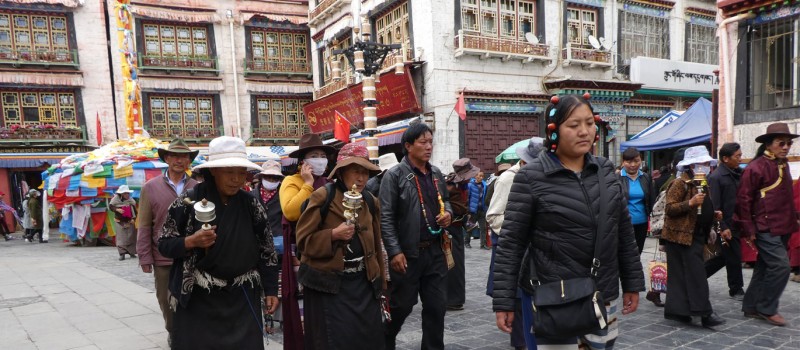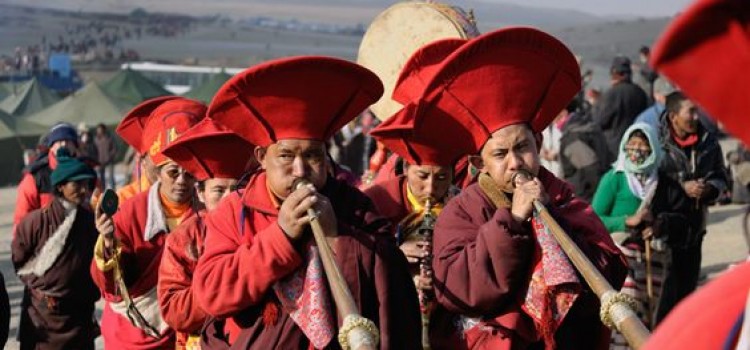Tibet tours to the “Roof of the World,” a land of breathtaking beauty, ancient spirituality, and profound cultural immersion. This mystical region, nestled high in the Himalayas, offers a unique travel experience unlike any other. From the awe-inspiring peaks of Mount Everest to the serene monasteries of Lhasa, Tibet will captivate your soul and leave you with memories that will last a lifetime.

Why the Tibet tour should be on your bucket list:
- Spiritual Awakening: Tibet is a deeply spiritual land, steeped in Buddhist traditions. Visit iconic monasteries like Potala Palace, Jokhang Temple, and Drepung Monastery, where you can witness monks chanting prayers and learn about Tibetan Buddhism. Immerse yourself in the peaceful atmosphere and find inner tranquility amidst the stunning mountain scenery.
- Unforgettable Landscapes: Tibet boasts some of the most breathtaking landscapes on Earth. Witness the majesty of Mount Everest, the highest peak in the world. Explore the vast and desolate Tibetan Plateau, with its rolling grasslands and crystal-clear lakes. Trek through breathtaking valleys, witness cascading waterfalls, and marvel at the panoramic vistas that will leave you speechless.
- Unique Culture and Traditions: Tibetan culture is vibrant, with unique customs, traditions, and festivals. Experience the warmth of the Tibetan people, learn about their nomadic lifestyle, and witness traditional dances and music. Indulge in delicious Tibetan cuisine, such as momos (dumplings) and tsampa (roasted barley flour), and savor the unique flavors of this high-altitude region.
- Off-the-Beaten-Path Adventure: Tibet offers a truly off-the-beaten-path adventure. Escape the crowds and immerse yourself in a unique and authentic travel experience. Explore remote villages, trek through pristine wilderness, and encounter wildlife such as yaks, antelopes, and snow leopards.
- Thrilling Adventures: For adventure seekers, Tibet offers a plethora of thrilling activities. Embark on a challenging trek to Everest Base Camp, go mountain biking through stunning landscapes, or try your hand at whitewater rafting on the Tsangpo River.
Planning Your Tibet Tour:
- Best Time to Visit: The best time to visit Tibet is during the spring (April-May) and autumn (September-October) when the weather is pleasant and the skies are clear.
- Getting There: The most common way to reach Tibet is by air, with flights available from major cities in China. You can also enter Tibet overland from Nepal.
- Permits and Visas: Foreigners require a special Tibet Travel Permit to enter the region. You can obtain this permit through a travel agency or by applying through the Chinese Embassy.
- Accommodation: Tibet offers a range of accommodation options, from budget-friendly guesthouses to luxury hotels.
- Transportation: Within Tibet, you can travel by bus, train, or private car.
Mt Kailash Tour Tibet:
Mount Kailash, a sacred site for Buddhists, Hindus, Jains, and Bonpos, is a must-visit destination for any traveler to Tibet. The Kailash Kora, a circumambulation around the mountain, is a challenging but rewarding pilgrimage.
- Mt Kailash Tour Tibet Group Joining Tour: Many travel agencies offer group joining tours to Mount Kailash, which can be a more affordable and social option. These tours typically include transportation, accommodation, and experienced guides.
Tips for Tibet tour:
- Altitude Sickness: Tibet is at a high altitude, so it’s important to acclimatize properly to avoid altitude sickness. Drink plenty of fluids, avoid strenuous activity, and rest frequently.
- Respect Local Customs: Tibet is a deeply religious region, so it’s important to dress modestly and respect local customs.
- Learn Basic Mandarin: While some Tibetans speak English, learning a few basic Mandarin phrases can be helpful for communication.
- Pack Warmly: Even in summer, temperatures can drop significantly at night, so pack warm clothes and layers.
- Hire a Local Guide: Hiring a local guide can enhance your travel experience by providing insights into Tibetan culture and history.
Tibet is a truly unique and unforgettable travel destination. With its breathtaking landscapes, rich cultural heritage, and spiritual significance, Tibet offers a journey of a lifetime. Whether you are seeking adventure, spiritual enlightenment, or simply a chance to experience a different way of life, Tibet will leave an indelible mark on your soul.
Start planning your Tibet tour today and discover the magic of this extraordinary land

